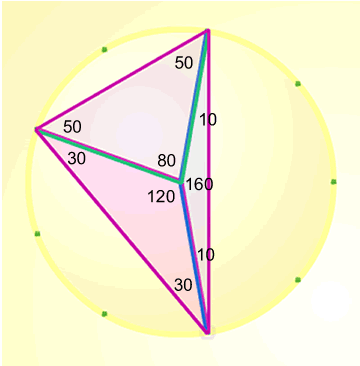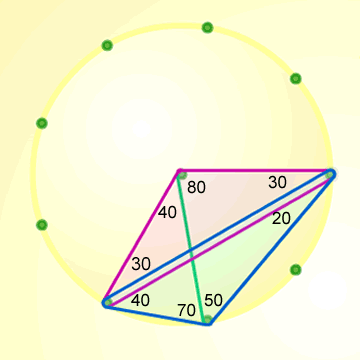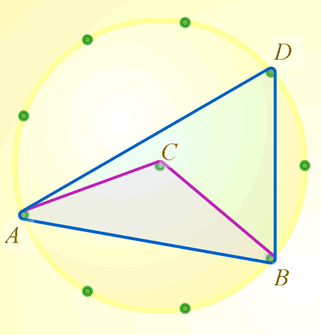Skip over navigation
Teachers may find the article Angle Measurement: an Opportunity for Equity of interest.
Demonstrate how the geoboard works - clicking on a coloured rubber band, dragging it onto a peg and then "stretching" it out onto two more pegs to make a triangle.
Draw a triangle that encloses the centre, split it into three isosceles triangles and find the angles.
An example may look like this:

"The angles around the centre add up to 360 degrees and the angles at the vertices add up to 180 degrees. What else do you notice about angles at the centre and angles at the vertices?"
Ask students to take a look at their working for Triangles in Circles to identify general rules that work in all cases. Encourage students to consider all the different possible angles at the circumference subtending a specific arc.
When the angle at the centre is a reflex angle, students may need some help to see that the angle at the circumference is still half the angle at the centre. For example:

A Virtual Geoboard allows you to create triangles in circles with a variable number of pegs. Ask students to check that the relationship between angles at the centre and angles at the circumference holds in 10 peg, 12 peg, 15 peg ... circles.



Or search by topic
Number and algebra
Geometry and measure
Probability and statistics
Working mathematically
Advanced mathematics
For younger learners
Subtended Angles
Age 11 to 14
Challenge Level 





- Problem
- Getting Started
- Student Solutions
- Teachers' Resources
Why do this problem?
This problem leads towards the theorem about the relationship
between the angle subtended by ("hanging from") an arc at the
centre of a circle and the angle subtended by the same arc at the
circumference. It's worth noting that once students know this
relationship, they will be able to deduce that angles subtended by
an arc at the circumference are all equal.
The nine-peg circle allows students to concentrate on the
geometrical structure without having to worry about the arithmetic.
A special case of this problem is
Right angles.
Teachers may find the article Angle Measurement: an Opportunity for Equity of interest.
Possible approach
All students will need a sheet of nine-peg
circles to jot down ideas during discussion.
Demonstrate how the geoboard works - clicking on a coloured rubber band, dragging it onto a peg and then "stretching" it out onto two more pegs to make a triangle.
Draw a triangle that encloses the centre, split it into three isosceles triangles and find the angles.
An example may look like this:

"The angles around the centre add up to 360 degrees and the angles at the vertices add up to 180 degrees. What else do you notice about angles at the centre and angles at the vertices?"
Ask students to take a look at their working for Triangles in Circles to identify general rules that work in all cases. Encourage students to consider all the different possible angles at the circumference subtending a specific arc.
When the angle at the centre is a reflex angle, students may need some help to see that the angle at the circumference is still half the angle at the centre. For example:

A Virtual Geoboard allows you to create triangles in circles with a variable number of pegs. Ask students to check that the relationship between angles at the centre and angles at the circumference holds in 10 peg, 12 peg, 15 peg ... circles.
Key questions
-
What is the relationship between the angle at the centre and the angle at the circumference?
-
What do we know already that might be useful here?
-
What are the implications of our findings? (How can other circle theorems be deduced from this one?)
Possible extension
-
Would the same thing happen if you started with an arc between any two points on the circumference of any circle?
-
Can you prove it?
Possible support
Students can work with several ready-made triangles like the
one below and asked to compare angles ACB and ADB. The sheet of nine-peg
circles could be used to draw these.

You may also like
On Time
On a clock the three hands - the second, minute and hour hands - are on the same axis. How often in a 24 hour day will the second hand be parallel to either of the two other hands?
LOGO Challenge 1 - Star Square
Can you use LOGO to create this star pattern made from squares. Only basic LOGO knowledge needed.

